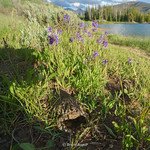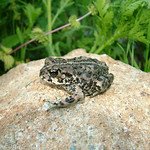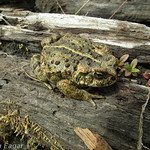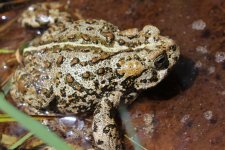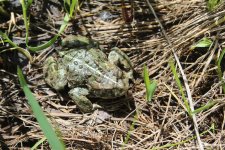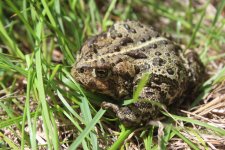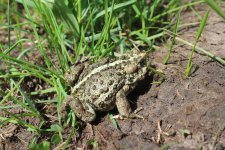| Range: |
 Known only from north central Rio Arriba County at elevations between 9100 feet and 10,500 feet in the San Juan Mountains at Canjilon Lakes, Trout Lakes and Lagunitas Lakes. Known only from north central Rio Arriba County at elevations between 9100 feet and 10,500 feet in the San Juan Mountains at Canjilon Lakes, Trout Lakes and Lagunitas Lakes.
|
| Other Names: |
|
| Subspecies: |
Boreal Toad Anaxyrus boreas boreas |
| Description: |
This is a medium-sized toad with cranial crests that are absent or only faintly evident. Warts are large and numerous with particularly large warts on the dorsal surface of the tibia. The well-separated, tear-shaped paratoid glands are about one and one-half the length of the upper eyelids. Thye overall coloration of the toad is darkbrownish to black and there is a distinct whitish vertebral stripe, which may be broken into segments of variable length. this middorsal stripe is usually lacking in juveniles. The tympanum is round and smaller than the eye. The tarsal fold, extending from the inner metatarsal tubercle almost to the heel, is well developed. There is often a well-defined light patch on the lower eyelid. The venter is buff or whitish, with considerable dark spotting on the chest. The underside of the feet may be yellowish, especially in the juveniles. Maximum SVL is usually less than 3.5".
The tadpole body is broadest between the eye and the spiracle. The eyes are nearer to the lateral margin of the body than to the dorsal midline. The tail fins are narrow, widest near the midpoint of the tail. The greatest height of the dorsal fin is nearly the same height as the musculature at the tail base. The ventral fin is similar in height to the dorsal fin. The anus is medial and emerges in the ventral fin. The spiracle is on the left side of the body near the middle. The general coloration is dull blackish with the underside slightly paler with little or no iridescence. The tail fin is clouded; it is without spots and marked with dense, minute melanic stippling, especially on the dorsal fin. The muscular portion of the tail is black. The labial tooth row formula is 2/3. |
| Habitat: |
Although reported to prefer beaver ponds, they may be found in high-elevation lakes, slow moving streams or low marshy areas. Dominant vegetation where they have been found consists of: corkbark fir,Engelmann spruce, aspen, willows and various sedges. Adults often seek cover in high grass surrounding wet areas. |
| Similar Species: |
At high elevations of northern New Mexico the only anuran sympatric with A. boreas is Pseudacris maculata. Adults of these two species may be easily separated by the smooth skin and lack of warts in P. triseriata. Tadpoles of A. boreas are uniformly black and the eyes are located dorsally. Pseudacris tadpoles are brown and the eyes protrude from the dorsolateral edge of the squarish body. The lack of cranial crests and shape of the paratoid glands will separate A. boreas from all other toads in New Mexico. Spoadefoots may be distinguished by smoother skin, a single metatarsal tubercle, and the vertically elliptical pupil. |
| Behavior: |
A. b. boreas is well known for its activity at low temperatures. Adult toads may be active during day or night at air temperatures as low as 37 degrees F. During the day they may sit in contact with the moist substrate in the sun where their body temperatures may be elevated to 86 degrees F or higher for several hours. Larvae may exhibit the same behavioral thermoregulatory patterns by remaining immobile in the deeper, colder water at night and moving to shallower, warmer water during the day. Both tadpoles and juveniles tend to aggregate at the warmest site available.
They can be active throughout the day with a period of reduced activity between noon and 2pm. Escaping toads usually jump into the water and seek refuge undr bottom debris or in mud. |
| Hibernation: |
These toads may overwinter in hibernacula which may be natural underground chambers with a continuous flow of groundwater beneath the floor of the chamber. Temperatures within these chambers remain near freezing. |
| Reproduction: |
Due to short growing seasons and cold nocturnal temperatures which limit food availability and restrict attainment of high body temperatures needed for digestion, growth rates of montane populations of boreal toads are very slow. Sexual maturity occurs within four and six years and males at 2.12" and females at 2.91" SVL. Egg clutches may be laid soon after the first snow melt during mid- to late June with metamorphosis occurring approximately two months after egg-laying, usually during late August or early September. Males generally lack a vocal pouch and even in breeding aggregations produce only release calls. |
| Diet: |
Various beetles, wasps and flies. |


